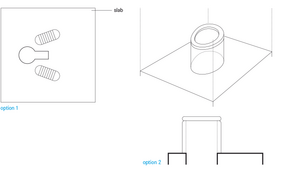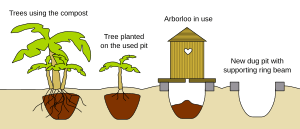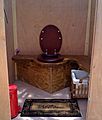Dry toilet facts for kids
A dry toilet is for depositing human excrement without using water, very different from flush toilets that use water. It may be for sitting or squatting. The urine may get mixed with the feces or be kept separate.
There are different types of dry toilets: composting toilet, urine-diverting dry toilet, Arborloo, container-based toilet, bucket toilet, pit latrine, incinerating toilet, or freezing toilet.
Types
All of these types of dry toilets work without flush water and without connections to sewers or septic tanks:
- Composting toilet - usually with feces, urine, and sometimes even kitchen scraps mixed together.
- Urine-diverting dry toilet (UDDT) – with urine kept separate to be used as an excellent fertilizer for plants, while the feces stay drier.
- Arborloo – which is like a pit latrine but the pit is smaller and the outhouse is light and can be moved to another pit, while a tree is planted on the old pit.
- Container-based toilet - with excrement going into containers that are taken to places where it is processed.
- Bucket toilet – simply a pail, but can also have urine separate and feces covered with dry material.
- Pit latrine - a hole in the ground.
- Incinerating toilet, freezing toilet – these are more complicated and expensive.
Other dry toilets are being developped, some with funding from the Bill and Melinda Gates Foundation.
Uses

There are four main reasons for using dry toilets:
- To save water and therefore money;
- To prevent water pollution;
- To recycle nutrients in agriculture, after treatment and storage to kill diseases;
- To adapt to places where sewers and wastewater treatment are not possible.
Dry toilets can be very presentable and are used in developed countries (for example, Sweden, Finland, and Norway), where they are often found at summer houses and national parks. They are more common in developing countries in places where flush toilets are not possible or not desired. Remember that sewers often cost too much where the land is rocky or irregular and where houses are far from one another.
Challenges
Some people strongly believe that dry toilets are the best way deal with excrement, others argue that they cannot be done everywhere, and others simply do not want to change their habits. Dry toilets reduce water consumption and pollution, recover valuable nutrients for agriculture, and (when managed properly) eliminate diseases and chemicals efficiently.
It has been difficult to install and manage many dry toilets in cities (for example, in the Erdos Eco-City of the Inner Mongolia Autonomous Region of China). Designs need to be fine-tuned and we need to be very careful during construction and management. The users also need to learn about the benefits of dry toilets and how to properly use them.
History
Further information: Toilet § History (in English Wikipedia)
Nearly all toilets were dry toilets, and excrement was valued in agriculture, until flush toilets were invented.
Great Britain
In Britain, dry toilets were still used in some areas (including cities) until the 1940s. It seems that these were often emptied directly onto gardens, where the excreta was used as fertiliser.[6] Sewer systems did not come to some rural areas in Britain until the 1950s or later.
Australia
Brisbane, Australia, was largely unsewered until the early 1970s, with many suburbs having dry toilets (called "dunnies") behind each house.
-
Historical German dry toilet with a mechanism to add peat moss to cover feces
Related pages
- Dry toilet publications in the library of the Sustainable Sanitation Alliance
Images for kids











